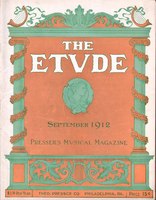Selected Content from the September 1912 Edition of The Etude
EMIL LIEBLING. Mr. Liebling was born in Pless, Silesia, April 12, 1851. He came to America early in life, and was soon engaged in teaching in schools and colleges. As soon as circumstances permitted he returned to Berlin, where he... Read More
The present article is by far the most eminent of Chopin’s pupils. Georges Mathias (1826-1910) was also a pupil of Kalkbrenner, and a graduate of the Conservatoire, where he subsequently became professor of the piano (1862-87). The article appeared in the Exercise Quotidiens of Isidor Philipp, and is here translated and reprinted from the French journal Musica. Mathias was a Chopin enthusiast, and like many of his kind a somewhat blind hero-worshiper. Nevertheless, he was an interesting personality, and the article not only gives a glowing description of Chopin, but also affords us a fascinating glimpse of Georges Mathias. Read More
This article, which appeared originally in the English Musical Opinion, is from the foremost English organist of our time. The distinctions he draws between the touch on the old and the new organs will be most interesting to our organ readers, and only that part of Mr. Lemare’s lengthy article is presented here. Read More
One of the pioneer concert organists of America was George Washbourn Morgan, who was born at Gloucester, England, in 1822, played in church in his native town at 8 years of age, and came to America in 1853. Read More
The London Orchestra tells a story of an organ recital at Exeter Hall, London, given when the organ was new, by Johann Schneider, of Dresden. Read More
This article will not interest the organist who has specialized, studied with some eminent organist and holds one of the largest organs in his town or city, at a salary of $800 or $1,000 a year up. It is written for the all-round musician who has taken up the organ as supplementary work, who plays as well as he can, on, let us say, a two-manual organ in the “average” church, for the sum of probably $3 to $5 a service. Read More
I suffered a hair-raising experience several years ago when I was organist of a church in a large town in the Midlands, the name of which—for obvious reasons—I will omit. Read More
The main essential of all “playing over” is that it should be done clearly and at the speed at which the singing is to go. There should always be sufficient tone to penetrate to every corner of the building. Beyond that, the amount of tone and the general character of the “giving out” should be in keeping with the hymn about to be sung. Read More
Pupils of Miss Katherine Morgan, Miss Lotta Glo Wallis, Mr. W. K. Steiner, Wm. A. Wolf, G. N. Benson, Harry L. Link, School of Musical Art, Miss Hermine Taenzer, Mrs. Bertha Stowell Gaynor, Miss Beatrice Holmes. Read More
A phonographic record has been taken of a baby twenty-six hours old … The grand scale on which the recent Saengerfest in Philadelphia has been carried out has recalled to many the tremendous efforts put forth at the World’s Peace Jubilee in Boston, forty years ago. Patrick Gilmore, then a young man of twenty or so, was responsible for the inception … Strauss’ Elektra is to be given in Russian at the Imperial Opera in St. Petersburg. After that it may as well be given in English … The momentous question as to exactly which hymn was played by the bandsmen of the Titanic as the vessel went down is now in a fair way to be decided. Read More
Examine Bach’s Fugue in D-major, “Well-tempered Clavichord” Vol. II, No. 5. Here you will find a figure of nine notes at the beginning and everything in the rest of the composition grown out of these nine notes, very much of it from the last four of these nine notes. A more usual kind of development (or “working-out”) may be found in Mendelssohn’s “Song Without Words,” No. 20. In this the melody begins with four chromatic notes in ascending progression. You would not dream of these being anything but a fragment of the melody, yet if you trace the music carefully you will find several other measures and phrases grown out of these four notes, and you will also discover other figures that are “logically worked out.” Read More
Although the American competitors in the Olympic Games in Sweden seemed to have the habit of establishing records, the German composers of to-day and yesterday are unquestionably the victors in all musical marathons. Few writers of other nationalities have ever had the persistence to write up to or beyond the Opus 1000. Read More




